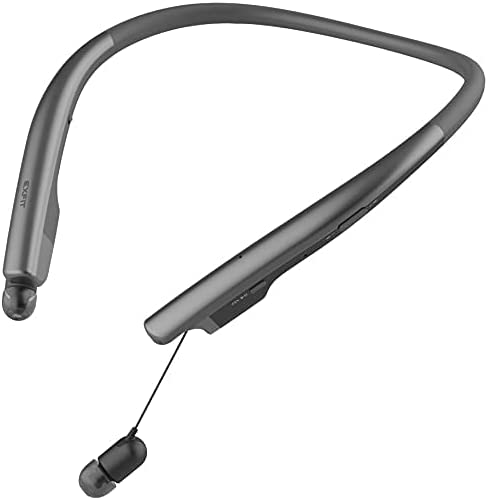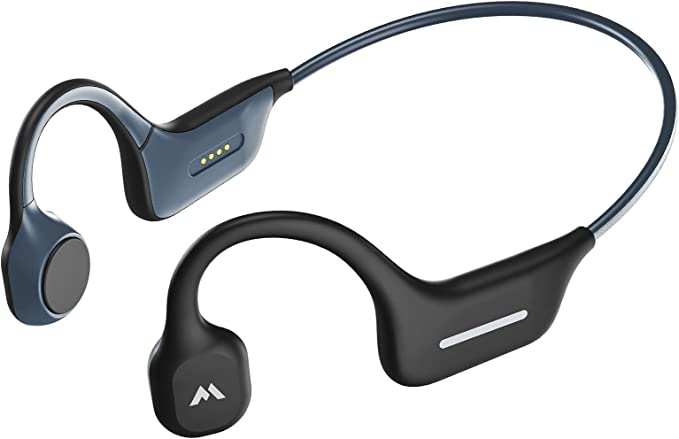We live enveloped in sound, much of it curated by choice. From the podcasts that accompany our commutes to the playlists fueling our workouts, headphones have become extensions of ourselves, crafting personal audio bubbles in a noisy world. Within the diverse ecosystem of personal audio devices, the neckband headphone holds a unique niche – an attempt to strike a balance between the untethered freedom of true wireless buds and the reassuring battery life and accessible controls often found in larger designs.
But how much thought do we give to the technology humming quietly around our necks? Let’s take a closer look, using the EXFIT BCS-700 neckband – based on the information available for it – not as a product review, but as a fascinating case study. Together, we’ll peel back the layers and explore the blend of wireless communication, mechanical ingenuity, acoustic science, and material considerations that make such devices possible. As an audio engineer, I find that understanding the ‘how’ and ‘why’ behind the features deepens the appreciation for the everyday magic we often take for granted.

The Invisible Handshake: Decoding Bluetooth Connectivity
At the heart of the BCS-700’s wireless capability lies Bluetooth. It’s a term we hear constantly, but what’s happening under the hood? Think of Bluetooth as a sophisticated, very short-range radio conversation. Operating within the globally recognized 2.4 GHz Industrial, Scientific, and Medical (ISM) band (the source material mentions 2.48 GHz, fitting within this range), it allows devices to exchange data packets without the need for physical cables.
When you “pair” your BCS-700 with your phone, they perform a digital handshake, establishing a secure, low-power link. This invisible tether is the lifeline that carries your music stream (using profiles like A2DP – Advanced Audio Distribution Profile) and handles your phone calls (via profiles like HFP – Hands-Free Profile). It’s this reliable connection that grants the freedom to move without being physically tethered to your audio source.
The product description mentions support for “HD Voice.” While the specifics depend heavily on your phone and mobile network, the underlying concept in Bluetooth involves using codecs (digital compression/decompression methods) that support a wider frequency range compared to traditional phone calls. Imagine the difference between an old AM radio broadcast and an FM stereo signal – HD Voice aims for that richer, more natural-sounding conversation by capturing and transmitting more of the nuances in the human voice.
And let’s not forget the subtle supporting actor: the vibration alert. This isn’t strictly audio tech, but it’s crucial haptic feedback. A quiet buzz for an incoming call or confirmation of pairing status provides a non-visual, often more discreet way to stay informed, especially when your phone is tucked away or you’re in a noisy environment. The ability to toggle this vibration on or off allows for user customization – a small but thoughtful touch.

Mechanical Magic: Taming the Tangle and Answering the Call
One of the defining characteristics of neckbands like the BCS-700 is the retractable earbud system. It seems simple – pull out to listen, retract to store – but it represents a significant mechanical engineering challenge. Inside the neckband, incredibly thin wires must navigate a path, spooling onto miniature spring-loaded reels, enduring potentially thousands of cycles of extension and retraction without kinking, fraying, or failing. The source material notes that the developer, BLUECOM, has a history involving patented retractable wire modules, hinting at the specialized expertise required to make this seemingly simple convenience reliable.
However, convenience can come with considerations. As noted in some user comments within the source text, very thin wires, by their nature, require a degree of care. This is a classic engineering trade-off: achieving minimal bulk and smooth retraction versus ultimate long-term robustness.
Building upon this mechanical foundation is the rather clever “Auto Answer” function. When a call comes in, simply pulling one of the earbuds from its housing automatically accepts the call. How does this work? While we can’t peer inside, the most likely mechanism is a simple sensor. It could be a tiny mechanical switch that’s physically tripped when the wire extends past a certain point, or perhaps a magnetic sensor detecting the movement. Whatever the specific implementation, it translates a simple physical action into a command – answer call. Imagine being in the car (where local laws permit hands-free use, of course) or having your hands full at work; this feature removes the fumble for a button, streamlining the process of taking an important call. It’s a small piece of thoughtful design aimed squarely at real-world usability.

Sculpting Your Personal Soundscape: Drivers, EQ, and the Walls of Silence
Ultimately, headphones live or die by their sound. The BCS-700 utilizes 8mm speaker drivers, housed within the earbuds. Think of these drivers as miniature versions of the large speakers in your home stereo, operating on the same fundamental principle of electromagnetism. An electrical audio signal, carrying the complex patterns of music or voice, flows through a tiny coil of wire (the voice coil) suspended in a magnetic field (usually from a small permanent magnet). This interaction causes the coil, and an attached lightweight diaphragm, to vibrate rapidly back and forth. These vibrations push and pull the air, creating pressure waves that travel down your ear canal and are interpreted by your brain as sound. The 8mm size refers to the diameter of the diaphragm; generally, a larger driver can move more air, potentially leading to a fuller sound, especially in the lower frequencies – aligning with the description of “Powerful Sound.”
But raw sound output is only part of the story. We all have different listening preferences, and audio content varies wildly. This is where Equalization (EQ) comes in. The BCS-700 offers three sound presets: Normal, Bass, and Treble, accessible via the play button. EQ is essentially an electronic tone control. It allows specific frequency ranges within the audio signal to be boosted (made louder) or cut (made quieter). Selecting “Bass” mode likely increases the amplitude of low-frequency sounds, giving music a heavier, punchier feel. “Treble” mode would boost the higher frequencies, potentially making vocals or instruments like cymbals sound crisper and clearer. “Normal” aims for a more balanced, uncolored representation of the original audio. This ability to tailor the sound profile is a key aspect of personalizing the listening experience.
The product information also mentions “Sound Isolation” under Noise Control. It’s important to distinguish this from Active Noise Cancellation (ANC). Sound Isolation, also known as passive noise reduction, doesn’t involve complex electronics actively counteracting external noise. Instead, it relies on the physical design of the earbuds and their tips (often silicone or foam) to create a snug seal within your ear canal. This seal acts as a physical barrier, significantly blocking out ambient noise – think of it like wearing earplugs that also happen to play music. It helps you focus on your audio by simply keeping much of the outside world out.

Ready for Your World: Durability and Awareness
Our headphones often venture with us into less-than-pristine environments – sweaty gyms, drizzly commutes, dusty workshops. The BCS-700 boasts an IPX4 rating, a standard defined by the International Electrotechnical Commission (IEC 60529). Let’s break down that code. “IP” stands for Ingress Protection. The first digit relates to protection against solid particles (like dust), where ‘X’ means it hasn’t been specifically tested or rated for this. The second digit, ‘4’ in this case, signifies protection against water splashes from any direction.
What does this mean practically? IPX4 indicates the device is designed to withstand sweat during a vigorous workout or getting caught in light rain. It’s splash-resistant. However, it is not waterproof. It cannot handle being submerged, nor can it withstand powerful water jets. Understanding this distinction is key to managing expectations and ensuring the longevity of the device. It’s built for the rigors of active use, but not for a swim.
While blocking out external noise is often desirable, there are times when situational awareness is crucial for safety – think jogging near traffic or waiting for an announcement at the train station. This is where the “Audio Transparency Mode” comes into play. This feature typically uses the same external microphones that might be used for phone calls. Instead of just capturing your voice, these mics pick up the ambient sounds around you. The headset’s electronics then process these external sounds and mix them into the audio feed you’re listening to. The effect is that you can hear your music or podcast while simultaneously hearing important sounds from your environment, like approaching cars or people talking to you, without needing to remove the earbuds. It’s a clever use of existing hardware to enhance safety and convenience.

The Long Haul: Power, Ports, and Featherlight Feel
All this technology requires power. The BCS-700 is listed with an 8-hour playtime on a single charge. This endurance figure is a result of balancing battery capacity with the power consumption of the Bluetooth radio, amplifier circuitry, and speaker drivers. Achieving multiple hours of playback in such a compact form factor is a testament to the efficiency of modern low-power electronics and battery technology (likely Lithium-ion based, though not specified). When the battery does deplete, a 2-hour charge time is stated to bring it back to full capacity.
The charging occurs via a port which, according to user comments in the source material, is a Micro-B USB connector. While perfectly functional, this connector type is less common on new devices today compared to the reversible USB-C standard. Its inclusion might reflect the design’s timeframe or cost considerations, but it’s a practical detail users will encounter.
Finally, let’s not overlook the importance of comfort, especially for a device designed to be worn for extended periods. The BCS-700 is described as “ultra-lightweight” at 1.6 oz (about 45 grams). Combined with its plastic construction and the neckband form factor distributing the weight across the shoulders rather than solely on the ears, this aims to minimize wearing fatigue, making it suitable for all-day use in an office or during long commutes.
Conclusion: The Symphony of Small Technologies
Peeling back the layers of a device like the EXFIT BCS-700 reveals a fascinating symphony of interconnected technologies. It’s not just one innovation, but the clever integration of wireless communication protocols, intricate mechanical design, fundamental acoustic principles, material science, and user-centric features like intuitive controls and environmental awareness modes.
From an engineering perspective, creating such a device involves constant balancing acts – convenience features like retraction versus the long-term durability of thin wires; battery life versus size and weight; acoustic performance versus cost. Understanding these elements doesn’t just demystify the gadget; it fosters an appreciation for the thought and ingenuity embedded in the objects that shape our daily sensory experiences. While specific models come and go, and technology relentlessly evolves (perhaps towards even more seamless integration or smarter features), the fundamental principles of sound, wireless communication, and user-focused design explored here remain the bedrock upon which our personal audio future will be built.




